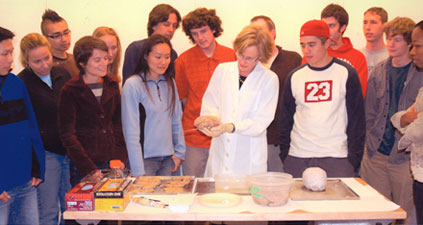Ann Graybiel
Email: graybiel@mit.edu
Curriculum Vitae: Download PDF

The research of Dr. Graybiel and her colleagues is of general significance for understanding how activity states of the forebrain are controlled and modulated during motor activity, procedural learning, and cognition. This work is of high clinical relevance for basal ganglia disorders such as Parkinson's disease and Huntington's disease, and also for neuropsychiatric disorders and addictive states in which behavioral patterns are dysregulated. The work of Graybiel and her group directly addresses the issue of how we can make and break habits, an issue of fundamental importance in human behavior.
Ann Graybiel and her group discovered chemical compartments in the striatum, a key basal ganglia structure implicated in the control of movement, cognition and habit learning. Direct links have been made between the "striosome" compartments that she and her group discovered and control of the dopamine system, which degenerates in Parkinson's disease. The striosomal system also is interconnected with cortical areas that, in humans, have been implicated in obsessive-compulsive disorder and Gilles de la Tourette syndrome. Together, these findings place the work of the Graybiel laboratory as a focus of clinical interest, and prompted her laboratory to use molecular as well as functional approaches to study the system.
There are many laboratories internationally that study the chemical compartments of the striatum originally delineated by the Graybiel laboratory. On the basis of this work, Ann Graybiel was awarded MIT's 2002 Killian Award, and the 2001 National Medal of Science. She was elected to the National Academy of Sciences of the USA in 1988, the American Academy of Arts and Sciences in 1991, the Institute of Medicine in 1994, elected Fellow in the American Academy of Neurology in 1997, and in 2002 was awarded the Killian Award, the highest honor given to an MIT professor.
Dr. Graybiel and her group have gone on to show that the compartmental architecture of the striatum represents a general principle of its organization, and that this functional architecture rivals in sophistication that of the cerebral cortex. The Graybiel group has likened this neural architecture to local expert learning architectures in computational neuroscience. They suggest that this organization may underlie the role of the basal ganglia in habit learning. This work has attracted the interest of members of the computational neuroscience community as a promising system for studying adaptive motor control. A number of models of the basal ganglia now emphasize the compartments the Graybiel group discovered as key components of these structures.
In their current work, the Graybiel group is recording the electrical activity of ensembles of neurons in the striatum and neocortex as rodents learn new maze tasks, as they then perform them as habits, and as they break the habits when placed in new contexts. The group is finding that a major reorganization occurs in the activity of striatal neurons as habits are learned, and as familiar tasks come to be performed in the nearly automatic fashion that typifies habitual activity. Activity is then restructured again as habits are broken or replaced. This work of the Graybiel laboratory is leading to an integrated view of the basal ganglia as forebrain structures concerned with learning to express the action plans that guide motor and cognitive-affective behavior. The group is recording simultaneously from the basal ganglia and neocortex in primates as the animals learn and perform sequences of eye movements and arm movements. They have found key signatures of learned sequence representations compatible with the idea that actions, like memories, can be chunked to maximize production efficacy.
Using gene-based methods Ann Graybiel and her colleagues study neuroplasticity in the striatum. Her laboratory pioneered work showing that drugs acting at dopamine synapses rapidly induce the expression of transcription factor genes in striatal neurons. They have now observed that these changes at the gene level closely parallel the behavioral changes induced by the drugs. They recently observed long-term changes in the compartmental distribution of early response genes whose expression is induced by psychomotor stimulants, and observed close parallels between these gene expression changes and the induction of behavioral stereotypies in the same animals. These findings have important implications for research on neuropsychiatric disorders and drug addiction. As part of their focus on gene regulation in this system, Ann Graybiel and her colleagues have cloned novel striatum-enriched genes in studies with Professor Housman. The Graybiel group has discovered the CalDAG-GEF gene family and is analyzing knockout and other mouse models to analyze these. These findings have wide potential implications, because the genes link the classic second messenger pathways using Ca2+ and DAG to Ras superfamily signaling.